I remember when I first arrived in Queensland. I literally saw red. Red fish that is, mangrove jack, the terror of the tropics.
It seemed impossible that I’d be living within 20 minutes of waters that held good jacks and I couldn’t wait to test my skills. Almost 10 years down the track I still have a passion for chasing these mighty red fish and I’ve learnt plenty about where it’s easy to catch them and where they’re almost impossible to catch.
One habitat that rarely gets talked about but holds plenty of jacks is the mangrove fringes in the bottom third of an estuary. I’m not talking about the large fallen mangroves that look so inviting, but I am talking about barren looking mangrove banks that are dry at low tide and covered by about a metre of water at high tide.
There are miles and miles of these banks in just about every estuary system and they are rarely fished by anglers, primarily because they do dry out at low tide and they are shallow at high tide. To fish them properly you have to be quiet, you have to drift or use an electric and you have to be able to cast lures well. And I don’t mean general vicinity casting either, I’m talking about being spot-on accurate because the targets you need to hit consistently are not that easy to get to.
So what is the perfect bank and how do I find it?
Pretty good questions and here’s how I go about looking for a good bank to prospect.
The first step, assuming you have time, is to go for a boat trip at low tide. Low tide is a hard time to get around some of our estuaries, but it’s the best time to find a few vital clues when looking for a good bank. The things to keep an eye out for are areas where the sand from the ocean and the mud from the land start to meet and form sand bars. Almost every estuary system has an area like this.
After you’ve found the right area, I look for straight stretches of river that are lined with mangroves that have their roots exposed at low tide. These stands of mangroves tend to grow near deeper channels, and that’s a vital point to note. You don’t want to find a great looking mangrove bank that has a 300m wide sand bar in front of it. Ideally you’d have a channel at least 2m deep at low tide butting into a sand bar that extends for perhaps 5-20m out from the mangroves. This set up gives the jacks a place to go at low tide and a place to hunt as the tide rises that wont take them on a massive swim just to reach some structure.
The last piece of the puzzle is to find a bank that has some of the mangroves jutting out slightly. A perfect scenario would be a bigger mangrove or a slightly fallen mangrove every 10m or so along a 100m bank. This gives you plenty to cast at while you drift with the tide.
The cast is the most important part of the equation, as you really do need to be centimetre perfect.
I use baitcasting tackle because I am far more accurate with it than threadline tackle, but both styles are appropriate if you have the skill. As you drift or electric up to a current breaker the first cast should be made so it lands right in the pocket where the mangrove first sticks out from the bank. If you’ve landed it right for God’s sake make sure you engage the reel quick smart as you will get slammed when the lure lands at some stage. As soon as you’re ready give the rod tip a sharp flick downwards. This will pop the lure under the surface. Don’t retrieve the line yet. After a brief pause, flick the rod tip down again and wind up the slack.
By now the lure will have drifted with the current and hopefully be under the overhanging branches or running along the front of the roots or branches sticking out. Continue with short, sharp flicks of the tip in an attempt to make the lure dart from side to side, but always leave time between the flicks.
If the lure get more than a metre out from the structure you may as well reel it in as fast as you can and get back in there with another good cast.
Your second cast will usually be to the front edge of the structure. This cast really needs to punch in as close to the structure in the water as possible. If there is an overhang of branches, try to skip cast under them or punch a cast through them. Again work the lure slow but hard so the lure is jiggling around in the strike zone.
The last cast, assuming you haven’t drifted too far, will be to the back edge. Try to punch the lure right up into the crook where the structure comes away from the main mangrove fringe and work the lure fast. You’ll be drifting quick so pauses in the retrieve are much harder to do, so keep punching the rod tip down and really get the lure dancing.
This is fast paced fishing and positioning the boat properly is half the battle. I am most accurate when casting about 10m with a baitcaster, so I position the boat about that distance from the structure. This short distance means I can cast into the structure, work the lure hard, crank it back in and shoot again. That is why I always use an electric motor. A foot-controlled electric allows you to concentrate on where you’re casting and how you’re retrieving rather than making sure the boat is not about to crash into the next juicy bit of structure.
An electric also allows you to go and retrieve snagged lures – and there will be plenty of those if you are trying to get the lure in the right spot!
Lures are lures right? Well they are but this fishing style demands a bit of attention to detail, something I am not good at usually.
All of my smaller jack lures are retrofitted with new split rings and hooks – apart from some of the Japanese lures that come with quality rings and hooks. I use Owner ST44 trebles, which aren’t the strongest hooks, but they are super sharp and jacks do not tear things apart like barra do. The split rings I use are either SPRO Power split rings or Owner Hyper Wires. Both are exceptionally strong for their size and won’t let you down.
More than any other lures I own, when I retrofit the lures I use, I always make sure I keep the weight about the same. Heavier hooks turn the Norries lures into sinkers, bigger split rings makes the Lucky Craft sink and the Rip’n Minnow will not swim the same if the hooks and rings are much heavier. The Bomber handles upgrades exceptionally well as it’s a high floater and the Rebel Minnow almost needs heavier rings and hooks just to make sure it keeps its nose down in the water when you work it hard as it has a tendency to explode out of the water with the original hooks and rings on it.
Whichever lure you choose, upgrade carefully and know how the lures swim before and after you re-rig them. And keep your lures between 7-9cm. The C’ultiva Rip’n Minnow is about the only lure jacks take regularly that is over 10cm long when you’re fishing the fringes.
Fringe fishing occupies lots of my jack fishing time. When conditions aren’t right for the surface, the fringes always work well. From the Tweed right through to the many creeks around Weipa I’ve fished the fringe successfully. Sometimes it takes a bit of coaxing to get a guide to move into the shallow stuff, but after a few brutal jack encounters I can guarantee it won’t be the last time they visit the fringe.
Give it a go yourself. From the moment there is a foot of water over the roots until there is a metre or so of water over them, the fringe is a great place to be.
If you want to see actual footage of what this article talks about, log onto www.fishingmonthly.com.au and click on the link on the front page for a short video of where and how we fish the fringe.
Facts
Favourite Lures
1. Bomber 14A
2. C’Ultiva Rip’n Minnow 110
3. Lucky Craft Bevy Shad 75SP
4. Norries Laydown Minnow 88SP
5. Rebel Minnow
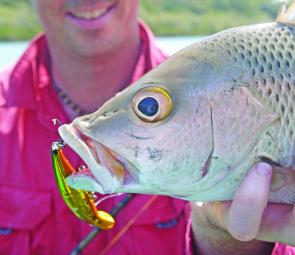
This fringe jack nailed the Bomber 14A as soon as it was first twitched.
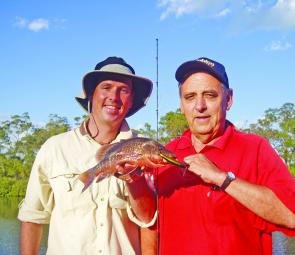
First time jack fisher Murray Ainsworth nailed this little jack early in the morning on an incoming tide fishing the fringe. The gold bomber 14A was the successful lure.
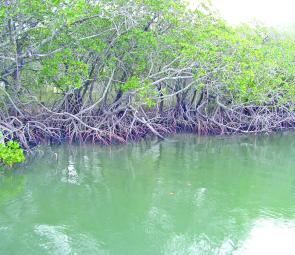
Just about ideal habitat. The tide is just about to put enough water over the roots and there are plenty of current breaking limbs and roots to target. This is Baffle Creek near Bundaberg at its best.
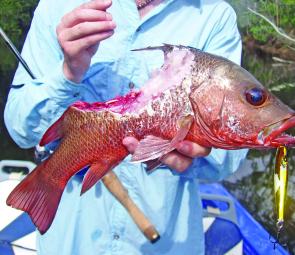
This is what happens when you struggle to get a jack out of the roots and then ease up on it – nailed by a whaler shark beside the boat.

When you find a patch of jacks on the fringes of the mangroves there are usually plenty about. These two came from the one current breaking, overhanging mangrove – one from the front, the other from the back end.

The Lucky Craft Bevy Shad is an awesome fringe lure when the water is just starting to get too deep. It’s suspending, deeper diving nature is perfect for the last run before you head to the snags.

This Hinchinbrook jack absolutely slammed the Bomber 15A. Slightly bigger and aimed at a barra, no-one was complaining when this jack smashed the lure in less than a foot of water.
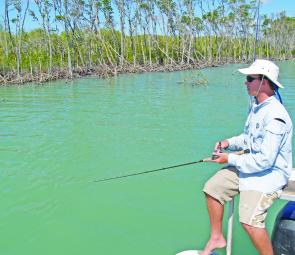
Josh Lyon works a shallow bank in Princess Charlotte Bay. While not the ideal mangrove fringe, this bank exhibits all the right points to hold jacks (and barra). Water less than a metre, fallen mangroves for cover and current rushing past as the tide come
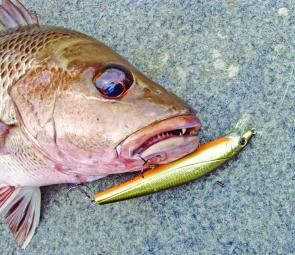
The C’ulitva Rip’n Minnow first came to our attention through Trent Butler. He worked on a retrieve method and nailed it so well the Rip’n Minnow is his go-to fringe lure.
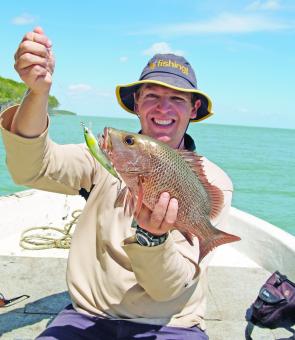
This Princess Charlotte Bay jack nailed an Ecogear Barra Special in less than a metre of water. Great fun.

Dirk Wendt landed this jack in the Macdonald River above Weipa. This was one of half a dozen jacks caught mid-tide in as the water flooded over the sand bank in the background and gave access to the mangrove roots.
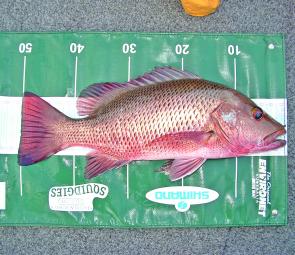
Some hefty jacks are in shallow water too. This Baffle Creek fish came from a shallow mangrove bank that had one half fallen mangrove breaking the current. The lure this time was a C’ultiva Rip’n Minnow 110.




